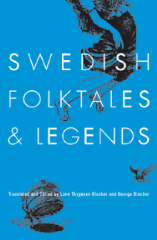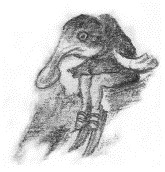This was meant to be a post about Prince Faithful, a Swedish fairy tale you can read in English in this great book.
The hitch in the plan was that the story is about a genius talking horse, and that all the horses I tried to draw were too appallingly bad to post on this blog. So there you go, one for another time perhaps. I’d still encourage you to grab a copy of Swedish Folktales & Legends. The stories have a very mythic, very epic feel. So if you’re a fan of Thor or Odin or Bilbo Baggins or any of that sort of stuff then you’ll probably like these.
Godfather Death also appears in that collection, as it does in several European fairy story books I’ve read recently (it even has its own Wikipedia page here). The Brothers Grimm have a version you can read online, but I prefer the Swedish because it has fewer of the Grimms’ sanctimonious interjections. In other words, the tale makes no apologies for the way the beggar rejects God in the tale. I liked that because it reminded me of a passage from the best book I read last year, Escapism by Yi-Fu Tuan, which goes like this
“Contrary to common belief, it is not the case that people in earlier times generally expected to survive death in the form of resurrected body or spirit to enjoy the rewards of paradise. Ethnographic and historical evidence suggests that the vast majority of human beings were too humble – too beaten by life’s recurrent insults and injuries, and too habituated to living in dire need surrounded by filth – to postulate living in heaven in bodily splendor. For personal survival in style to be conceivable, there must first be a strong sense of individuality, of being a person who in this life can alreqady engage in enterprises of worth and valor.”
– Yi-Fu Tuan, Escapism, p.71
I didn’t really like the way WordPress jumbled the pictures and text together for The Feathered Ogre, so I’ve written up Godfather Death on its own page. Click on the below little chap to go to it.
It’s safe to say that this is a peculiar and morbid fairy story, but there’s some heroism in there too. The physician himself might not manage to cheat death, but he is successful in doing so on the behalf of others. As for the pictures, they’re all straight rip-offs of paintings by Heironymous Bosch. I wasn’t sure at first how to go about drawing God in the woods, but then it seemed natural to copy The Garden of Earthly Delights, because I like the way God looks isolated and distant and a little sad in that painting. Likewise I like it that the devil is wearing a cauldron for a hat and jam jars for slippers.


Death is ripped off from Bosch’s The Seven Deadly Sins and the Four Last Things. It was good to replicate Bosch in this way because it made me think it might be fun to draw some of his strange, biology-defying beasties from his paintings in a larger scale, as if they were zoological diagrams. Then I remembered that I’d already done something similar by accident: the horses I drew for Prince Faithful.


